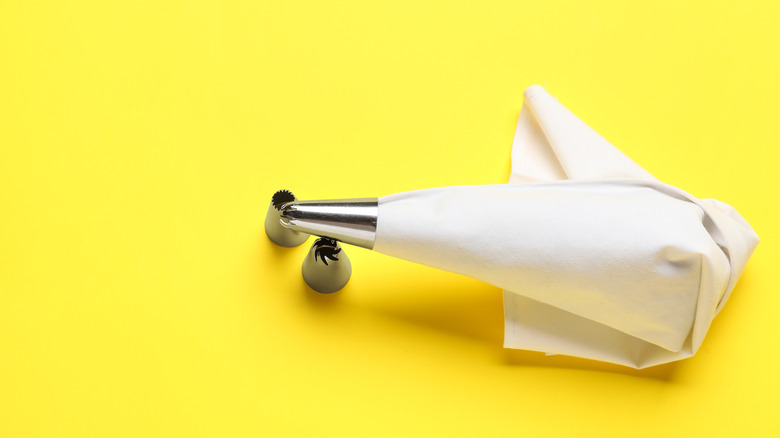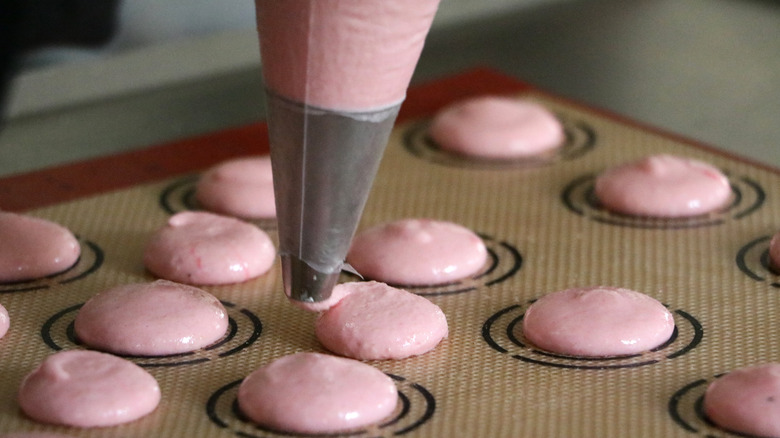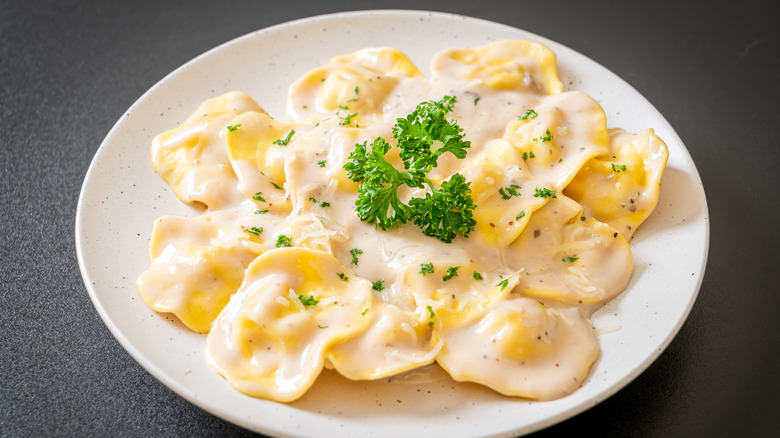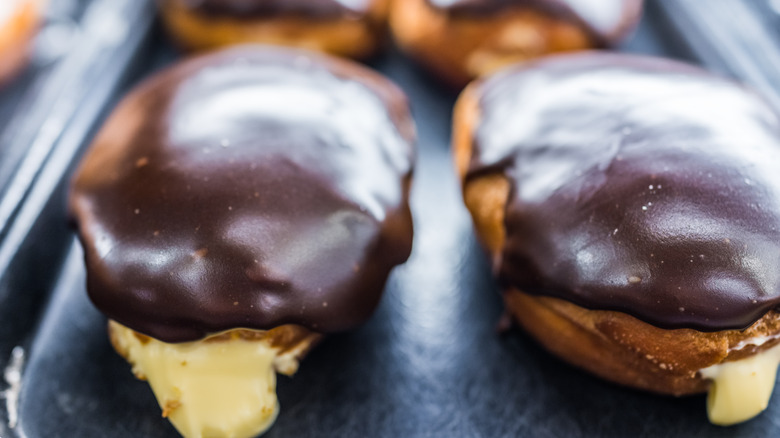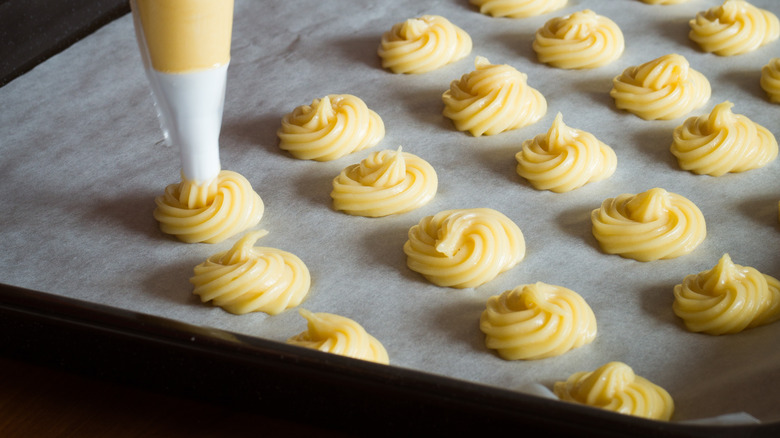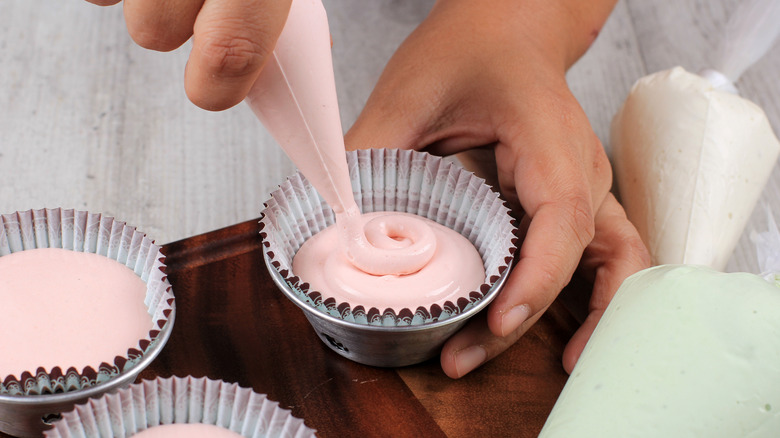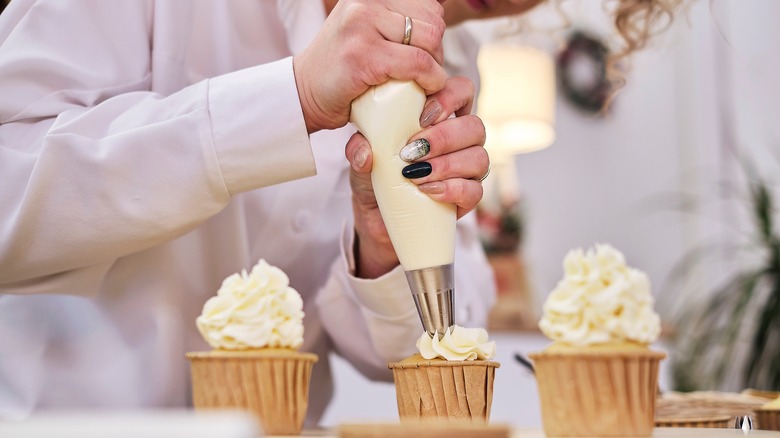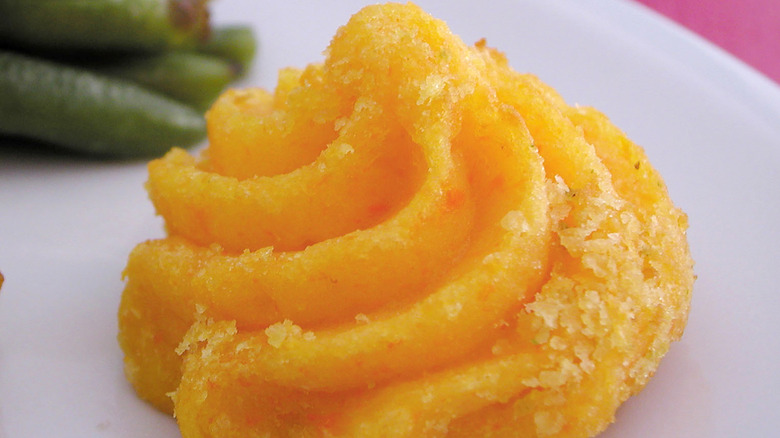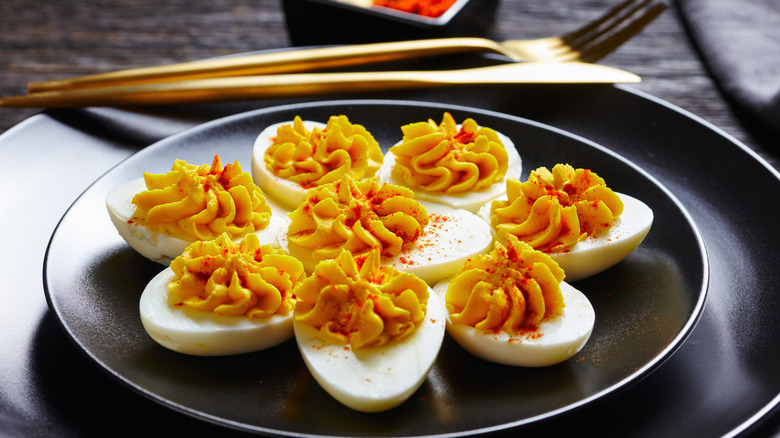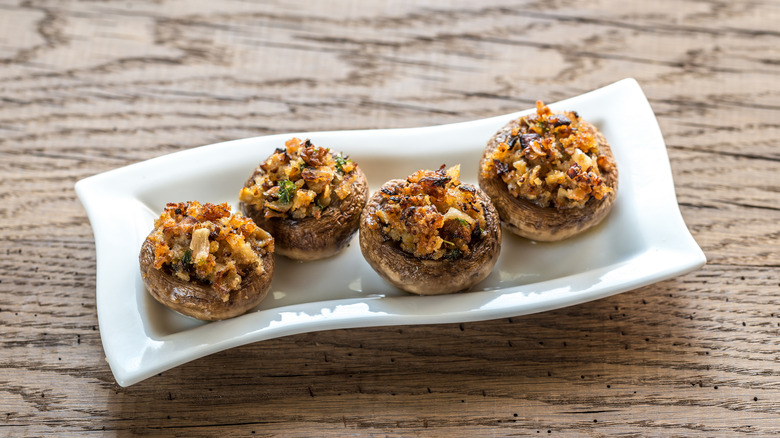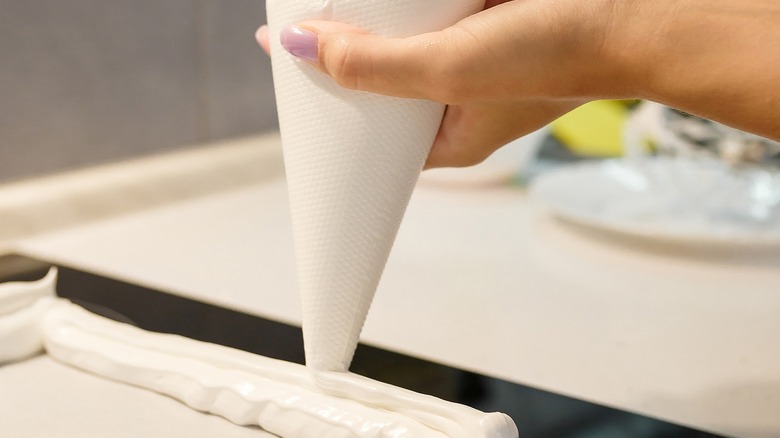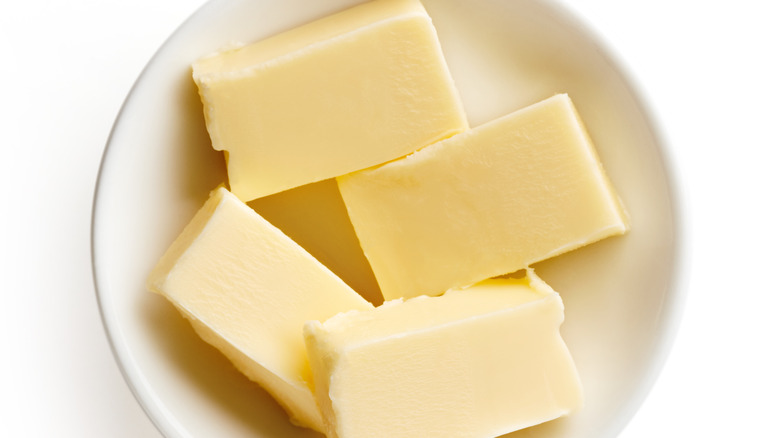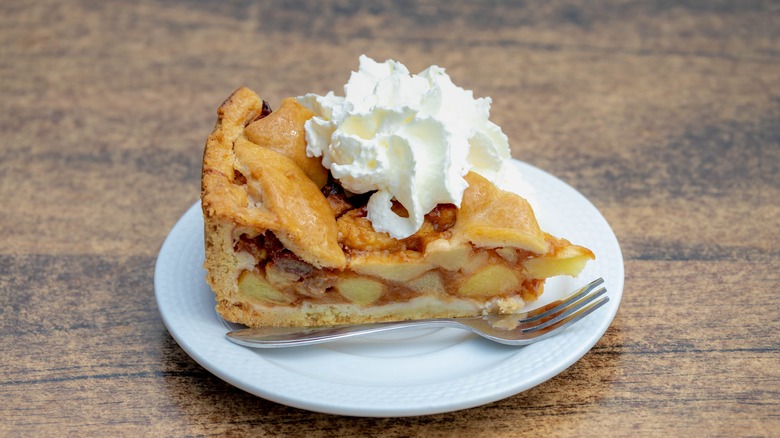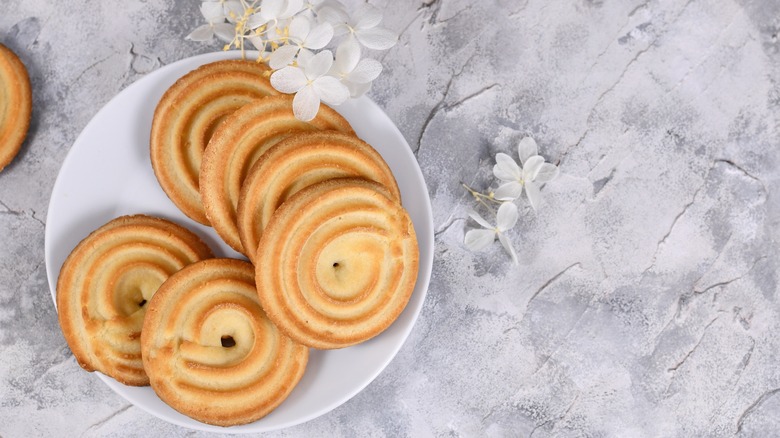The 14 Absolute Best Uses For Your Pastry Bag
Pastry bags are one of the Swiss Army knives of the baking world. These bags, which are usually made from plastic, canvas, or nylon, are cylindrical in shape and include a hole at the top of the bag for filling. When the filling is added, a small hole is made at the tip of the bag for dispensing the filling. Bakers can affix different metal tips to the bag as well for special designs. According to My Budget Recipes, pasty bags and piping bags are not the same things, although these tools are often used interchangeably in the vernacular. Pastry bags are often called icing bags because they are larger and able to accommodate more filling than piping bags, which are often used for smaller designs and writing.
Although the pastry bag has a deeply intertwined history with sweet applications, there are many different uses of the bags outside of piping sweet icings. Here are some of our most creative recommendations for how to use your pastry bag.
Piping macarons
Macarons are no doubt one of the trickier cookies for home bakers. A pastry bag is an essential tool for making symmetrical macaron "feet." Macaron feet are made with almond flour, egg white, and an Italian meringue base that must be dried in the oven before it can be sandwiched between a delicious jam or sweet center. If you are making macarons at home, you should be careful with how much you fill your pastry bag. Filling the pastry bag ⅓ to ½, rather than to the brim, is ideal for making macarons because you can more easily maneuver the bag and keep the same angles of the bag to the baking mat. It will also be less heavy on your hands so you can concentrate on making perfect discs.
We recommend piping a couple of "tester" macarons before you move on to piping the rest of the batch. This will allow you to check the texture of the batter before you have to decide what the best avenue for piping will be.
Stuffing pastas
If you've ever made stuffed shells or manicotti before, you know how tough it can be to spoon in the delicate filling to the pasta without scalding your fingers — or getting the filling all over yourself and your kitchen. Pastry bags can lend a hand in making sure that you pipe into the pasta, rather than outside the pasta, as well as give you better leverage for how much filling you are adding to your stuffed pasta.
This hack works better for smooth fillings rather than super chunky fillings. If you try a baked stuffed shells recipe with ricotta and sausage, you're going to want to be sure your sausage is minced as finely as it can be. Otherwise, you can expect the tip of the bag to become easily clogged with meat chunks. If you come across this problem, take a toothpick to dislodge the entrapment and continue piping.
Filling donuts
Who doesn't love a soft-filled donut? The key to getting the perfect filling on a donut is to use a pastry bag rather than your hands. Craftsy recommends using ¼ to ⅓ cups of filling for each donut, depending on the size. For the optimal filling experience, work with donuts that have cooled enough; donuts that are too hot will merely melt the filling and result in a piping mess.
The website recommends having a chopstick of a skewer handy to pierce the outside of the donut; this will make more space for the filling once it is added. Then, insert just the rounded tip and fill the donut until the filling starts to come back at you. Instead of a rounded tip, Craftsy recommends trying a decorative tip instead so that you can do a couple of tiny rosettes over the piping hole. Using a pastry bag for piping cream works for most fillings including Bavarian cream and jam.
Piping pancake batter
Spooning pancake batter with a ladle or a spoon means you will get drippings all over your pan and your kitchen. Instead, using a pastry bag makes cooking your pancake batter so much easier and mess-free. Simply fill the bag with the batter and slice off the top and you're ready to make delicious pancakes.
The other mess-free alternative to this hack is to use a washed-out condiment bottle to transfer the pancake batter to an awaiting griddle. But this method comes with its downsides. Besides the potential of your bottle sputtering out batter and getting its tip lodged with a ball of flour, you have to wash yet another kitchen tool at the end of the day. Disposable pastry bags are easier to clean (because you can toss the bag in the trash). Unlike other types of batter, pancake batter is too thin to pipe. So, we recommend just sticking with a round tip or going naked with just the bag itself.
Making homemade choux
Choux is one of the seven major types of pastry that is the base for éclairs, cream puffs, and gougères. Choux dough is cooked over heat until some of the moisture evaporates from the dough before being cooled and mixed with eggs. The pastry is airy, soft, and decadent when filled with pastry cream or other toppings.
You can use a pastry bag and rounded tip to pipe pâte à choux onto a baking sheet. The pâte à choux dough is hearty enough to withstand the pressure of the bag and if it is properly mixed, will not result in the tip getting clogged too much. Moreover, using a pastry bag for piping choux dough ensures that all of the choux is the same size as it bakes. And since French patisserie is all about precision and detail, we can confidently say here that size does matter.
Filling muffin tins
There are numerous mess-free alternatives for filing cupcake tins — including using a squeeze bottle, cookie scoop, or pouring straight from the bowl. But if you want efficiency and a low-mess experience, a piping bag is the way to go. Squeeze bottles, while convenient, are rarely in a large enough size to squeeze enough batter through. The cookie scoop and the bowl method run the risk of dripping all over your pan (and we should note that these little flecks of batter always seem inordinately difficult to clean off the tray).
Piping bags also give you the most about of control when you're piping muffin or cupcake batter. If you pipe too much batter into your muffin tin, your batter has the volume to seep over the top of the muffin tins and into the oven — potentially burning and ruining your batch of blueberry muffins. Instead, keep to filling the cups ¾ of the way to the top.
Piping buttercream icing onto desserts
Learning how to pipe icing with a pastry bag is a critical skill that will eventually allow you to work with thinner piping bags and more delicate applications like writing. While you can use the tried-and-true offset spatula method, you won't get the same aesthetic experience of a piped glob of icing on top of your cupcakes. Using a pastry bag will have your cupcakes looking bakery-case ready in a matter of minutes.
Buttercream frosting is the perfect companion for a piping bag because it is thick, flavorful, and holds its shape after being piped. If you need an additional ingredient to help your buttercream frosting hold its shape, the proof is in the fluff. Marshmallow fluff is a thick, yet pipe-able, ingredient that results in a stiff shape after it's been piped. Your icing won't go sliding off your freshly baked cupcakes and will result in the decadent marshmallow flavor that produces a delicious vanilla after-taste.
Making ornate mashed potato designs
Mashed potatoes bring back memories of Thanksgiving and shepherd's pie, but have you ever tried piping your mashed potatoes? Piping mashed potatoes add a gourmet flair to your simple mashed potato night, plus it can be baked on top of shepherd's pie. Duchess potatoes, as the delicately piped mashed potatoes, egg yolk, and butter are otherwise known, are believed to have originated in France between the 1700s and 1800s. At the time, potatoes were not considered a favorable dish, so chefs tried to present the dish with a name fit for royalty — thus duchess potatoes were born, (via Chef Gourmet). After the potatoes are piped, the mounds are doused with melted butter and baked in the oven until lightly brown.
Duchess potatoes are the perfect pairing for exquisite meats like prime rib and pork tenderloin. Plus, you can make ornate designs with a variety of tip designs and shapes.
Filling deviled eggs
Love it or hate it, deviled eggs are a popular snack and appetizer at tailgates and parties. These eggs are made from hard-boiled egg whites with the yolks removed. The hard-boiled yolks are then mixed with a binder (like mayonnaise) and seasonings before being added back into the hole in the egg white. The method by which you add the yolks back into the egg can be complicated and messy. If you go with the kitchen spoon method, you may overfill the eggs or leave a tacky residue all over your fingers. Plus, the finish on the eggs will be undesirably messy.
For serving-ready deviled eggs, use a pastry bag instead. You should first be sure to run the yolks through a fine strainer so that small yolk chunks won't clog the tip of the bag. When it's time to set up for piping, we recommend using a star tip for a nice aesthetic design. Try to fill your eggs with one tablespoon of filling per egg and top with paprika.
Filling stuffed appetizers
Appetizers are the best part of fancy celebrations. And what better way to get a clean filling than consulting your pastry bag? The pastry bag allows you to add filling to tiny crevasses without the mess. Stuffed cherry peppers are a delicious appetizer idea that is much easier with a pastry bag. These one-bite appetizers can be made with savory provolone or prosciutto, but the basic ingredients include ricotta and cream cheese. While your fingers or a small spoon are some of the preferred methods for stuffing the tiny cherry peppers, using a piping bag will result in a cleaner method of filling.
Cherry peppers aren't the only appetizer that can be made easier with the help of a pastry bag. Jalapeño poppers are stuffed with a mixture of cream cheese, cheddar cheese, scallions, and seasonings before being coated in bread crumbs and toasted in an air-fryer. As long as your pastry bag's tip is wide enough, you can fill these peppers with ease.
Piping meringues
Meringues are some of the most finicky baked goods that you will undoubtedly need a pastry bag to create. Meringue cookies and pavlova are just two recipes you can make out of the perfect meringue batter. You'll need four simple ingredients to make meringues at home — egg whites, sugar, vanilla extract, and cream or tartar. After the batter is stiff enough to bake, you can prepare your bags for piping. For meringue cookies, you should select a tip with a 2-inch width and pipe in small spirals. Meringue is naturally very sticky, so it is important to leave about an inch of space between the cookies.
When piping the pavlova, you should pipe in large disc shapes on the lined baking sheet. Then, you should use a spatula or the back side of a spoon to flatten the meringue; this is important so the layers of whipped cream don't cause the top meringue layer to go tipsy once it's formed.
Piping butter for a special event
Slabs of butter on toast don't always look professional. But you can pipe whipped butter into tiny ramekins for an easy way to upgrade a breakfast plate. Making whipped butter at home is very easy and just requires beating butter sticks at a high speed for three or four minutes, occasionally scraping down the sides of the bowl to concentrate the mixture. Then, transfer the mixture to a pastry bag to start piping it into your chosen shape. You can use a star-shaped tip for tiny butter rosettes to garnish mashed potatoes or pancakes or go for a swirl tip to pipe alongside prime rib.
Whipped butter is a versatile garnish that can be flavored with your favorite ingredients and extracts. We love delicious honey-whipped butter on freshly baked biscuits or a vanilla-extract aroma from a sweet whipped butter concoction on top of pancakes.
Decorating with whipped cream
Whipped cream goes on everything — so why not add a cool flair with a piped whipped cream design? You can make your own homemade whipped cream by combining a few simple ingredients, the base of which is whipping cream, into a bowl and mixing at a high speed. Unless you use a stabilizing agent like meringue powder, you should make your whipped cream as close to the time you need it as possible. This is because the high fat level of the cream allows air to be whipped into it, giving it its shape and unctuous flavor, (via Blue Flame Kitchen).
When your whipped cream comes together in stiff peaks, it is ready to pipe. Add your desired tip to the pastry bag and pipe your whipped cream on top of your pumpkin pie or apple pie, or as a delicious flavoring for your morning coffee.
Piping butter cookies
Butter cookies are a delicious type of cookie distinguished by a soft, buttery flavor and spiral shape. You'll need to use a pastry bag to shape these cookies; a star-shaped tip is ideal to get the butter cookie swirls.
The key to getting the perfect butter cookie swirl starts with preparation. Your butter should be room temperature — not too cold, not too hot — so it is easy to work with and pipe. Creaming the butter and sugar together is important as well to increase the aeration of the cookie dough. To keep the same piped shape during baking, the key is to refrigerate the dough for about a half-an-hour before baking. This will solidify the butter a bit and reduce the flattening effect of the oven.
Butter cookies are a great mid-afternoon snacking cookie or as a dessert pairing. You can leave the cookies as-is, or decorate them with a bit of sprinkles as desired.
